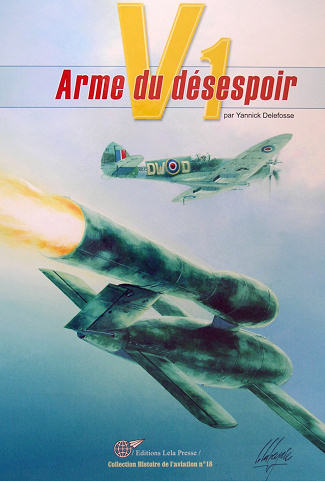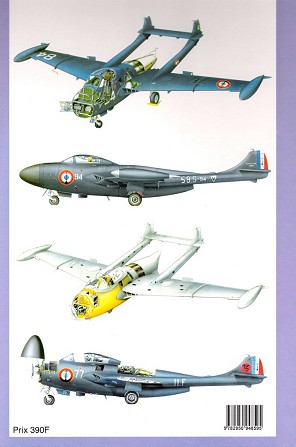|
Title: |
V1
Armes du désespoir |
|
Author: |
Yannick Delefosse |
|
Publisher/Distributor |
Lela Presse |
|
Price |
€ 45 |
|
Reviewer: |
Jean – Paul Poisseroux |
|
Notes: |
240 pages, Hardbound
221 pictures, 35 in color, 36 V1 drawings, 65 architectural drawings, 10
maps. French text |
 6 June 1944 at dawn, the Allied
create the surprise in Normandy, the beginning of the end for the Germans. 13
June 1944, the Germans also create a surprise, with a long range unmanned
weapon, exploding near Gravesend at 4.13 A.M. 22574 other unpleasant terror
weapons will follow it until march 1945. If the air raid from the allied side
were terrible, but visible thanks to the engines strakes, this cold death coming
from anywhere, put troubles in the civilian and military authorities. Finally,
too late to counter the D-Day preparations, and failing to help the declining
Luftwaffe, the “last chance, last hope” missile start the new area in the
warfare.
6 June 1944 at dawn, the Allied
create the surprise in Normandy, the beginning of the end for the Germans. 13
June 1944, the Germans also create a surprise, with a long range unmanned
weapon, exploding near Gravesend at 4.13 A.M. 22574 other unpleasant terror
weapons will follow it until march 1945. If the air raid from the allied side
were terrible, but visible thanks to the engines strakes, this cold death coming
from anywhere, put troubles in the civilian and military authorities. Finally,
too late to counter the D-Day preparations, and failing to help the declining
Luftwaffe, the “last chance, last hope” missile start the new area in the
warfare.
This death object is
neither an AFV, nor an airplane, and it’s certainly the reason why studies are
rather poor on the subject. Of course some books exist, but you’ll find most of
the same pictures in them. This new one is written by a French author,
specialised on military research in the North of France. If you remember that
the V1 sites were mostly dispatched on the north coast, you’ll understand why
this book can be qualifying as “exceptional”. You’ll learn not only about the
weapon itself, but all the logistic aside. A kind of “then and now” tribute.
About the weapon you’ll have 36 wartime drawings, but the piece of cake include
approx 65 sharp scaled drawings of almost everything around. You’ll discover the
different launching ramps, the shelters, the different houses for the crews, the
stock area, the buildings, the warehouse, the depot, the bunkers, the railways
system, sequence on assembly, checking, handling, and much more with cross
sections which will allow modellers to replicate a complete launching site (if
space is not a problem!). Aside this gorgeous materials, actual pictures of the
remains sites in the Nord- Pas –de- Calais, Normandy, and Somme are displayed
and it’s amazing to see the well preservation status on some of them. In this
way, it’s a good field guide to people interesting in the matter. A well
preserved machine in color is a good support for technical data, as wartime b/w
pictures from the both sides with propaganda and crews for the German chapter.
On Allied side, aerial site pictures and unexploded missile view complete the
study. 10 geographical maps give good information on the V1 net, and an
impressive listing review 610 bases with a mass of characteristics on sites.
This is the more complete study on the subject, and for a long time. EXCELLENT
job! JP
July 2006
For more on the complete
line of Lela Presse books, visit
http://www.avionsbateaux.com/
haracteristics:
A-4
format, hard cover, 368 pages, 47pictures in color, 482 in b/w, drawings (
in 1/72 scale), 33 drawings from technical manual, 8 color profiles, 3 3D
cutaways,. French text.
At the end
of Second World War, the French navy squadrons were equipped with propeller
fighters (mostly Seafires), while the jet area had started to live with the
Germans, English, and Americans aircrafts. The swan song was obvious and
the military authorities edited programs for a modern renewal of the air
forces. Despite the trials of four homemade aircrafts, none got
satisfaction. The solution for temporally equipment was to look outside,
and the test of the sea vampire in late 1946 in Britain attracted
attention. Finally it led to the order of 96 Sea Venom for the French navy
first line ranks.
Here is
the story of the first jet carried fighter of the after war, written by a
former Chance Vought F-8[FN]Crusader rider.
Covered
with a front eye catching painting, the big volume is divided in seven
parts, twenty chapters and five appendix.
1st
part : the Aquilon rise (the challengers, the aquilon emerge, on
board trials, in service)
2nd
part : In formation (Flotilles 11.F,16F, 2.S, 10.S, 54.S, 59.S,
CUERS, CLEMENCEAU)
3rd
part : Operation in
North Africa
(Bizerte
and Algerian war)
4th
part : Armament (weapons, targets)
5th
part : Technical (specifics tech, equipment, novelties acquired with
the Aquilon).
6th
part : Appendix (night fly courses in USA, HMS Ark Royal, individual
carreers)
7th
part : Portfolio (color pictures and profiles).
 The mass of pictures,
tech details is impressive, with very good b/w overall situation and close
up shots. Aside the aircraft, we discover in chapter 3, some vertical shots
of the main Air Bases in Africa, as some other airplanes involved in this
unpleasant “war” (never seen before). The large inside details with
drawings help to understand the lay out of this side by side seats
aircraft, and the life on board of the French Clemenceau carrier is very
interesting. Weapons and folding wings system which are often forgotten in
books, have a great section on them. The very fine drawings, added to the
exceptional 47 color pictures and 8 profiles closed this really beautiful
research on a beautiful bird design by De Havilland. As a lot of parts are
common with the British Sea Venom, this volume will certainly catch
attention of the Royal Navy fellows. Recommended also for modellers who
have boxes from Toko, Frog ,Premiere in 1/72 scale, Aeroclub in 1/48 scale,
and Matchbox in 1/32 scale
The mass of pictures,
tech details is impressive, with very good b/w overall situation and close
up shots. Aside the aircraft, we discover in chapter 3, some vertical shots
of the main Air Bases in Africa, as some other airplanes involved in this
unpleasant “war” (never seen before). The large inside details with
drawings help to understand the lay out of this side by side seats
aircraft, and the life on board of the French Clemenceau carrier is very
interesting. Weapons and folding wings system which are often forgotten in
books, have a great section on them. The very fine drawings, added to the
exceptional 47 color pictures and 8 profiles closed this really beautiful
research on a beautiful bird design by De Havilland. As a lot of parts are
common with the British Sea Venom, this volume will certainly catch
attention of the Royal Navy fellows. Recommended also for modellers who
have boxes from Toko, Frog ,Premiere in 1/72 scale, Aeroclub in 1/48 scale,
and Matchbox in 1/32 scale
December
2005
Available
at:
http://www.avionsbateaux.com/
If
you would like your product reviewed fairly and quickly by a site that has
over 300,000 visitors a month, please
contact me
or see other details in the
Note to Contributors.
 6 June 1944 at dawn, the Allied
create the surprise in Normandy, the beginning of the end for the Germans. 13
June 1944, the Germans also create a surprise, with a long range unmanned
weapon, exploding near Gravesend at 4.13 A.M. 22574 other unpleasant terror
weapons will follow it until march 1945. If the air raid from the allied side
were terrible, but visible thanks to the engines strakes, this cold death coming
from anywhere, put troubles in the civilian and military authorities. Finally,
too late to counter the D-Day preparations, and failing to help the declining
Luftwaffe, the “last chance, last hope” missile start the new area in the
warfare.
6 June 1944 at dawn, the Allied
create the surprise in Normandy, the beginning of the end for the Germans. 13
June 1944, the Germans also create a surprise, with a long range unmanned
weapon, exploding near Gravesend at 4.13 A.M. 22574 other unpleasant terror
weapons will follow it until march 1945. If the air raid from the allied side
were terrible, but visible thanks to the engines strakes, this cold death coming
from anywhere, put troubles in the civilian and military authorities. Finally,
too late to counter the D-Day preparations, and failing to help the declining
Luftwaffe, the “last chance, last hope” missile start the new area in the
warfare. The mass of pictures,
tech details is impressive, with very good b/w overall situation and close
up shots. Aside the aircraft, we discover in chapter 3, some vertical shots
of the main Air Bases in Africa, as some other airplanes involved in this
unpleasant “war” (never seen before). The large inside details with
drawings help to understand the lay out of this side by side seats
aircraft, and the life on board of the French Clemenceau carrier is very
interesting. Weapons and folding wings system which are often forgotten in
books, have a great section on them. The very fine drawings, added to the
exceptional 47 color pictures and 8 profiles closed this really beautiful
research on a beautiful bird design by De Havilland. As a lot of parts are
common with the British Sea Venom, this volume will certainly catch
attention of the Royal Navy fellows. Recommended also for modellers who
have boxes from Toko, Frog ,Premiere in 1/72 scale, Aeroclub in 1/48 scale,
and Matchbox in 1/32 scale
The mass of pictures,
tech details is impressive, with very good b/w overall situation and close
up shots. Aside the aircraft, we discover in chapter 3, some vertical shots
of the main Air Bases in Africa, as some other airplanes involved in this
unpleasant “war” (never seen before). The large inside details with
drawings help to understand the lay out of this side by side seats
aircraft, and the life on board of the French Clemenceau carrier is very
interesting. Weapons and folding wings system which are often forgotten in
books, have a great section on them. The very fine drawings, added to the
exceptional 47 color pictures and 8 profiles closed this really beautiful
research on a beautiful bird design by De Havilland. As a lot of parts are
common with the British Sea Venom, this volume will certainly catch
attention of the Royal Navy fellows. Recommended also for modellers who
have boxes from Toko, Frog ,Premiere in 1/72 scale, Aeroclub in 1/48 scale,
and Matchbox in 1/32 scale